How much better would your products be if you could improve engineering productivity by reducing engineering time wasters? Engineers regularly lose productivity to non-value-add tasks that not only rob them of their ability to innovate, but also threaten their company’s ability to compete, differentiate, and grow. Imagine the potential of identifying and removing the most…
- Executive Summary
- Product Development Is Critical to Business Strategies
- The Time Wasters
- Implications of Time Wasters to the Business
- A Solution to Avoid Time Wasters
- Defining Product Complexity
- Business Value from PLM
- Extending PLM Use Results in Greater Satisfaction
- How Companies implement PLM
- Additional Values Due to the Cloud
- Conclusions
- Recommendations
- About the Research
- Acknowledgments
Executive Summary
Engineers Impact Business Success Exceptional products are critical to success, regardless of whether a company's business strategy is to grow or improve margins. Likewise, engineers are crucial to ensuring products have what it takes to succeed in the market. Therefore, empowering engineers is key to the successful execution of business strategies. Too Many Time Wasters
Unfortunately, engineers report spending too much time on non-value-added work with too many interruptions, taking them away from critical innovation work. Furthermore, 96% of surveyed companies say this loss in engineering productivity comes at a significant business cost due to missed deadlines, higher costs, less innovation, and poor quality. To overcome productivity losses, one approach is to manage product data better and make it accessible to those who need it, when they need it.
Reclaiming Wasted Time
This report identifies major engineering time wasters and examines them across the dimensions of both company size and product complexity. It explores how companies of all sizes reclaim lost time by examining the use and value of PLM (Product Lifecycle Management) solutions to centralize data across multiple domains, manage processes, and collaborate better. PLM users reported fewer changes due to outdated information and errors, significantly reducing non-value-added work and shortening development times. This report also looks at how companies select and use PLM solutions, including cloud-based implementations.
Too Many Time Wasters
Unfortunately, engineers report spending too much time on non-value-added work with too many interruptions, taking them away from critical innovation work. Furthermore, 96% of surveyed companies say this loss in engineering productivity comes at a significant business cost due to missed deadlines, higher costs, less innovation, and poor quality. To overcome productivity losses, one approach is to manage product data better and make it accessible to those who need it, when they need it.
Reclaiming Wasted Time
This report identifies major engineering time wasters and examines them across the dimensions of both company size and product complexity. It explores how companies of all sizes reclaim lost time by examining the use and value of PLM (Product Lifecycle Management) solutions to centralize data across multiple domains, manage processes, and collaborate better. PLM users reported fewer changes due to outdated information and errors, significantly reducing non-value-added work and shortening development times. This report also looks at how companies select and use PLM solutions, including cloud-based implementations.
Conclusions
Reclaiming Lost Time Smaller and medium-sized companies prioritize their future growth and sustained success on winning in the marketplace with better, differentiated products. To support this, they can give their product development capabilities a significant boost by eliminating the time wasters that consume engineers' valuable time. Companies of all sizes find that PLM can empower their engineers to innovate by significantly reducing engineers' time on non-value-added tasks. As a result, they can enjoy a competitive advantage. In addition, technology advances, such as cloud-based offerings, can reduce implementation time, cost, and difficulty, making PLM more accessible to smaller and medium-sized companies.Recommendations
Next Steps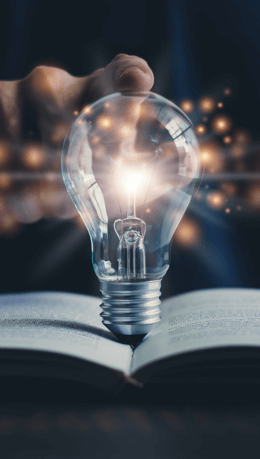 Based on industry experience and research for this report, Tech-Clarity offers the following recommendations to smaller and medium-sized companies:
Based on industry experience and research for this report, Tech-Clarity offers the following recommendations to smaller and medium-sized companies:
- Consider the business impact of engineering time wasters on your company and make investments to minimize them. By empowering engineers to focus more time on value-added work, you will get to market faster with better, more differentiated products.
- Consider how challenging it can be to find and recruit engineering talent in today’s business climate. Freeing engineers from time-wasting tasks can help take some pressure off your existing staff, improving their work environment and productivity, and reducing the need to add more.
- Look at PLM as a potential solution to reduce engineering time wasters. Smaller and medium-sized companies report that PLM offers benefits such as centralizing data, supporting multiple domains, managing processes, and improving collaboration. This frees engineers from tasks that waste their time so they can focus more on engineering and innovation.
- Use PLM for more than managing data. Those most satisfied with PLM also use it to manage engineering change processes, access control, requirements, and release processes.
- Extend the use of PLM to a broader audience beyond engineering. Those most satisfied with it include management, manufacturing, quality, and sales as users.
- Select a solution that has the flexibility to configure to your processes. An overwhelming 74% who found the implementation easy, identified this as helpful to the implementation.
- Consider a cloud solution. Interestingly, 78% of those who implemented a cloud solution considered the deployment easy and implemented it in half the time required by those using a non-cloud solution.
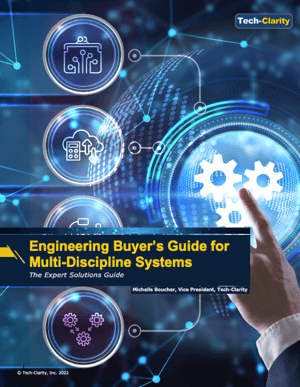 What should you look for in a systems engineering solution for your company to manage multi-discipline systems?
As products become smarter and more connected, they also get more complex. Expert systems engineering practices can help to manage this complexity, especially when you are developing multi-discipline systems. The right technology can also be critical to support those practices. This buyer’s guide, Engineering Buyer’s Guide for Multi-Discipline Systems: The Expert Solutions Guide, provides a framework to evaluate systems engineering solutions to help you select the right solution for your company. It provides checklists for software requirements across multiple aspects of systems engineering, requirements to make the implementation a success, vendor requirements, and special considerations. By evaluating these requirements, you will be better positioned to select the right solution to successfully manage multi-discipline systems.
Please enjoy the summary* below. For the full research, please visit our sponsor PTC (no registration required).
What should you look for in a systems engineering solution for your company to manage multi-discipline systems?
As products become smarter and more connected, they also get more complex. Expert systems engineering practices can help to manage this complexity, especially when you are developing multi-discipline systems. The right technology can also be critical to support those practices. This buyer’s guide, Engineering Buyer’s Guide for Multi-Discipline Systems: The Expert Solutions Guide, provides a framework to evaluate systems engineering solutions to help you select the right solution for your company. It provides checklists for software requirements across multiple aspects of systems engineering, requirements to make the implementation a success, vendor requirements, and special considerations. By evaluating these requirements, you will be better positioned to select the right solution to successfully manage multi-discipline systems.
Please enjoy the summary* below. For the full research, please visit our sponsor PTC (no registration required).
Table of Contents
- Executive Overview
- The Business Value of Systems Engineering
- Start with Process Definition
- Manage Requirements
- Design the System
- Design the System to be Modular
- Support Product Line Variants
- Enable Detailed Design
- Support Connectivity
- Verify and Validate the System
- Assess Service Requirements
- Consider Vendor Attributes
- Identify Specific Needs for Your Company
- Conclusion
- Recommendations
- About the Author
- Acknowledgments
Executive Summary
Fierce global competition continues to drive companies to seek new ways to competitively differentiate their products. Many achieve this differentiation through smarter and more connected products. This approach creates many innovative possibilities for new products and services.
 While smarter products and connectivity create exciting opportunities for innovation, they also bring unique challenges and add new levels of complexity. Much of this complexity comes from requirements to integrate mechanical components, electronics, and software. Connectivity adds further complexity as you add sensors, streaming data, and an ecosystem of connected systems. Whether you are a systems engineer, product architect, or domain-specific engineer, addressing this complexity requires expert systems engineering practices.
While smarter products and connectivity create exciting opportunities for innovation, they also bring unique challenges and add new levels of complexity. Much of this complexity comes from requirements to integrate mechanical components, electronics, and software. Connectivity adds further complexity as you add sensors, streaming data, and an ecosystem of connected systems. Whether you are a systems engineer, product architect, or domain-specific engineer, addressing this complexity requires expert systems engineering practices.
To set the foundation for expert systems engineering practices, companies should focus on the entire systems engineering process, ensuring there are solutions for all aspects of systems engineering. Expert systems engineering practices will help companies become even more competitive in ways that will lead to higher growth and greater profitability.
The right technology is an essential part of implementing and supporting these expert systems engineering practices. The right technology will enable improved collaboration, better traceability with a digital thread, and earlier visibility to potential problems. This will result in a more efficient development process while reducing the risk of finding errors late in the process, helping to avoid delays and increased costs. This buyer’s guide will help manufacturers select the right software to support systems engineering.
This guide comprises four major sections covering systems engineering software tool functionality, service requirements, vendor attributes, and special company considerations (Figure 1). Each section includes a checklist of key requirements to support your selection process for systems engineering software tools.

Conclusion
Expert systems engineering practices are vital to take advantage of innovation available through  embedded software and the Internet of Things. The opportunities to create smart, connected devices can help companies set their products apart from the competition, helping them win new customers and increase revenues. However, bringing together systems of mechanical components, electronics, and software is complex. That complexity grows exponentially as companies try to meet the various needs of customers with different configurations. Connected systems add even further complexity as you add sensors, streaming data, and connected ecosystems.
embedded software and the Internet of Things. The opportunities to create smart, connected devices can help companies set their products apart from the competition, helping them win new customers and increase revenues. However, bringing together systems of mechanical components, electronics, and software is complex. That complexity grows exponentially as companies try to meet the various needs of customers with different configurations. Connected systems add even further complexity as you add sensors, streaming data, and connected ecosystems.
Complexity increases the risk that things will go wrong. The impact of these problems can have a significant business impact and hurt product profitability. Implementing expert systems engineering practices, with the right software tools to support them, can manage this complexity, making it easier to successfully bring profitable products to market. Even if today’s smart, connected devices are relatively simple, as they evolve and offer critical services such as those that impact safety, they will increase in complexity and need the same level of expert systems engineering practices.
These practices and the supporting solution are not just limited to systems engineers either. There are a variety of IoT-related roles involved with planning, designing, and architecting connected systems, such as IoT solution architects, who will struggle with the exact same challenges as systems engineers. Companies planning for growth should consider both current and future needs.
However, there are so many aspects of systems engineering; determining the right solution for your company can be very difficult. Using a high-level list of tool and process evaluation criteria such as the ones in this guide can help narrow down potential solutions. The lists provide a quick “litmus test” to determine if a solution and partner are a good fit before conducting detailed functional or technical reviews. In the end, it is crucial to ensure that functionality, service, vendor, and special requirements are all considered when selecting a solution.
 How can manufacturers bounce forward from disruption with smart manufacturing? Read our short post for some insights from our research and then join a live event to learn from Tech-Clarity's Jim Brown and a variety of other speakers in a live Industry 4.0 event.
How can manufacturers bounce forward from disruption with smart manufacturing? Read our short post for some insights from our research and then join a live event to learn from Tech-Clarity's Jim Brown and a variety of other speakers in a live Industry 4.0 event.
Industry Disruption is the New Normal
Today’s global manufacturing industry is more susceptible to global disruptions than ever. In the past decade, we’ve had to recover from earthquakes, volcanoes, tsunamis, political uncertainty, and a global pandemic. These events have led to demand volatility, supply chain disruptions, and workforce impacts. Consequently, our research finds that about three-quarters of companies have experienced an increase in business risk and disruption over the prior five years.Responding to Adversity by Bouncing Forward
The manufacturing industry, however, did not give up. Instead, our research shows that:- 86% of companies increased their focus and attention on digital transformation as a response to disruption
- 49% of companies accelerated technology adoption.
Top Performers Get More Value by Acting on Digital Data
One of the keys to success is digitalizing data and processes. Our research shows that Top Performing companies are:- 50% more likely to have fully digital design data than poorer performing companies.
- Three times as likely to have fully digital design and development processes.
- Three times as likely to integrate IT and OT data and systems.
- More than three times as likely to be able to provide access to manufacturing data in time to impact performance.
Interested in More?
Don’t miss out on the opportunity to learn how to navigate your smart factory initiatives at our exclusive event on April 28th 12:00pm-4:30pm at the Great Lakes Brewery in Cleveland, OH. The jam-packed agenda includes industry expert panel, a networking Lunch, a deep dive roundtable session, and a happy hour (where the real secrets are revealed)! This is your opportunity to learn how industry leaders took advantage of the emerging technology and lowered costs while simplifying operations. Register now to network with industry peers and experts. Limited seating at this intimate event! For full event information and registration please visit the event sponsor, FactoryEye. Click here to view the full list of speakers. You can also view the event brochure here. A version of this post originally appeared as a guest post on the FactoryEye site.
[post_title] => Bouncing Forward with Smart Manufacturing (guest post)
[post_excerpt] =>
[post_status] => publish
[comment_status] => open
[ping_status] => open
[post_password] =>
[post_name] => smart-manufacturing-factory-eye
[to_ping] =>
[pinged] =>
[post_modified] => 2022-11-14 22:25:42
[post_modified_gmt] => 2022-11-15 03:25:42
[post_content_filtered] =>
[post_parent] => 0
[guid] => https://tech-clarity.com/?p=11188
[menu_order] => 0
[post_type] => post
[post_mime_type] =>
[comment_count] => 0
[filter] => raw
)
[3] => WP_Post Object
(
[ID] => 11221
[post_author] => 2
[post_date] => 2022-04-01 12:08:57
[post_date_gmt] => 2022-04-01 16:08:57
[post_content] =>
A version of this post originally appeared as a guest post on the FactoryEye site.
[post_title] => Bouncing Forward with Smart Manufacturing (guest post)
[post_excerpt] =>
[post_status] => publish
[comment_status] => open
[ping_status] => open
[post_password] =>
[post_name] => smart-manufacturing-factory-eye
[to_ping] =>
[pinged] =>
[post_modified] => 2022-11-14 22:25:42
[post_modified_gmt] => 2022-11-15 03:25:42
[post_content_filtered] =>
[post_parent] => 0
[guid] => https://tech-clarity.com/?p=11188
[menu_order] => 0
[post_type] => post
[post_mime_type] =>
[comment_count] => 0
[filter] => raw
)
[3] => WP_Post Object
(
[ID] => 11221
[post_author] => 2
[post_date] => 2022-04-01 12:08:57
[post_date_gmt] => 2022-04-01 16:08:57
[post_content] =>  Is PLM living up to its potential in consumer packaged goods? Is it ready to support today's digital transformation strategies? What is the status quo for PLM in CPG? We surveyed over 150 companies to find out.
Please enjoy the summary below.* For the full report, please visit our sponsor Kalypso (registration required).
Is PLM living up to its potential in consumer packaged goods? Is it ready to support today's digital transformation strategies? What is the status quo for PLM in CPG? We surveyed over 150 companies to find out.
Please enjoy the summary below.* For the full report, please visit our sponsor Kalypso (registration required).
Table of Contents
- The Digital Transformation Imperative
- PLM Plays a Vital Role in Digital Transformation
- PLM Provides Multi-Faceted Business Value
- The Untapped Value of PLM
- Extending PLM Value Requires Vision
- PLM Implementations Must be Made Future Ready
- Identifying Top Performing CPG Product Developers
- Adopt More Digital Product Design Approaches
- Be More Strategic About PLM
- Utilize PLM More Broadly
- Take Advanced Approaches to Product Definition
- Leverage Advanced Product Formulation Techniques
- The State of PLM Implementations
- Move to the Cloud
- Conclusions
- About the Research
- Acknowledgments
Is PLM Meeting Its Potential?
PLM: Innovation Platform of Product Governance Utility? Product Lifecycle Management (PLM) promises enhanced product innovation and faster time to market, leading to higher market share and increased profitability. Who doesn't want these strategic, top-line benefits?
PLM implementations, however, typically focus on increasing control, compliance, governance, quality, and product development efficiency. Those are valuable benefits, but are they enough? Is PLM living up to its potential? And is PLM ready to support today's digital transformation strategies?
Product Lifecycle Management (PLM) promises enhanced product innovation and faster time to market, leading to higher market share and increased profitability. Who doesn't want these strategic, top-line benefits?
PLM implementations, however, typically focus on increasing control, compliance, governance, quality, and product development efficiency. Those are valuable benefits, but are they enough? Is PLM living up to its potential? And is PLM ready to support today's digital transformation strategies?
PLM Plays a Vital Role in Digital Transformation
Support Digital Transformation PLM is the backbone of the digital enterprise. Respondents rated the importance of PLM to the strategic initiatives discussed above. A full 85% of companies see PLM as critical or important to digital transformation, and one-quarter say it is critical. On the other hand, only 3% see it as not important or relevant to supporting this strategic business imperative. Support Digital Threads, Twins The conclusion that PLM plays a vital role in digital transformation is supported by its importance for digital thread and digital twin initiatives. Over one-half of CPG companies say that PLM is important or critical to supporting the digital thread. Respondents report very similar views on the importance of PLM to support digital twin initiatives. The findings confirm our experience that PLM is an important part of digital transformation in the CPG industry.The Untapped Value of PLM
Achieve Top-Line Benefits CPG companies surveyed for this study were asked what goals they have achieved from PLM. The top two benefits, faster product development and improved product innovation, can lead to higher market share and greater revenue. Increased quality may also help improve sales and the top line. About half of the CPG companies polled report they receive each of these benefits. They also reported cost savings and operational benefits.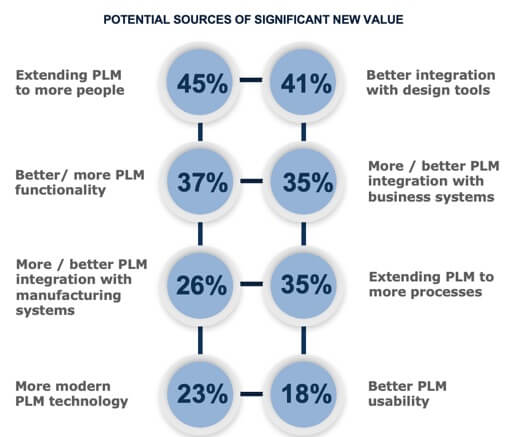 Extend PLM
CPG companies can achieve greater benefits if they extend their PLM systems to more people, greater functionality, and additional processes. The most commonly reported driver of significant new value for CPG companies is extending PLM to more people. In many cases, this may be possible with their existing PLM solutions. The same is likely true for extending PLM to more processes. For some, they may also be able to implement capabilities in their existing system that are currently going unused.
Improve Integration
In addition to extending PLM, or perhaps supporting it, is better PLM integration. Between one-third and one-half say that better integration with design tools would add significant value. Integration increases efficiency, collaboration, and the ability to iterate design options. This integration may include formulation, packaging, label design, and CAD tools. Beyond tool integration, many companies report they would gain higher value with better / more integration with business systems, which likely includes ERP and potentially others like CRM and MES.
Extend PLM
CPG companies can achieve greater benefits if they extend their PLM systems to more people, greater functionality, and additional processes. The most commonly reported driver of significant new value for CPG companies is extending PLM to more people. In many cases, this may be possible with their existing PLM solutions. The same is likely true for extending PLM to more processes. For some, they may also be able to implement capabilities in their existing system that are currently going unused.
Improve Integration
In addition to extending PLM, or perhaps supporting it, is better PLM integration. Between one-third and one-half say that better integration with design tools would add significant value. Integration increases efficiency, collaboration, and the ability to iterate design options. This integration may include formulation, packaging, label design, and CAD tools. Beyond tool integration, many companies report they would gain higher value with better / more integration with business systems, which likely includes ERP and potentially others like CRM and MES.
Conclusions
Top Performers Show That PLM Systems Can Deliver More Value PLM provides significant top-line, bottom-line, and operational value for CPG companies. Surveyed companies report multiple business benefits ranging from time-to-market improvements to increased compliance and traceability. Even with the high level of value realized, there is more to be achieved by extending PLM further. Top Performers set the stage to show how Others can get the most out of their current PLM investments. Top Performers, more than Others:- View PLM as a strategic platform for product innovation
- Recognize the value of PLM internally and in the value chain
- Extend PLM to more departments
- Digitalize data and processes
- Use more (and more advanced) PLM capabilities
- Use more advanced data modeling and simulation capabilities
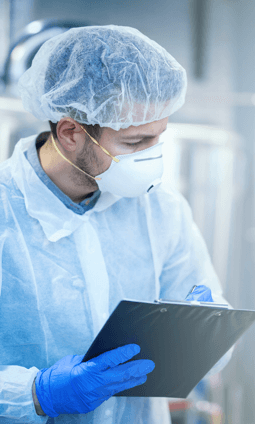 The majority of CPG companies believe their existing PLM systems are adequate for their current needs. But they also recognize that PLM is vital
to achieving their highly strategic, digital transformation initiatives. The current status quo of using multiple systems, which are typically customized and not fully integrated into the ecosystem, is an inhibitor to achieving digital transformation and extended value. Not surprisingly, the majority of surveyed participants don’t believe their current PLM system will meet their company’s future needs.
Top Performers point the way toward the future of PLM. They adopt PLM as a platform for the enterprise and supply chain that is more integrated, more advanced, more widely adopted, and kept more current. It’s important to note that the systems have typically been heavily customized, and not everyone can afford the tradeoffs between customization, cost, and keeping implementations up to date. But they are rewarded with better innovation, product development, and compliance – all of which help drive higher profitability.
The Future is Bright, But There is Work to be Done
PLM is already driving a lot of value, but the status quo finds most CPG companies unprepared for the future. PLM needs are changing, and PLM must adapt and evolve. CPG companies that want to retain or improve their product innovation performance must continue to improve their PLM implementations and capabilities.
*This summary is an abbreviated version of the ebook and does not contain the full content. For the full report, please visit our sponsor Kalypso.
If you have difficulty obtaining a copy of the research, please contact us.
[post_title] => The State of PLM in CPG (survey results)
[post_excerpt] =>
[post_status] => publish
[comment_status] => open
[ping_status] => open
[post_password] =>
[post_name] => plm-in-cpg-survey-results
[to_ping] =>
[pinged] =>
[post_modified] => 2022-11-14 22:28:59
[post_modified_gmt] => 2022-11-15 03:28:59
[post_content_filtered] =>
[post_parent] => 0
[guid] => https://tech-clarity.com/?p=11221
[menu_order] => 0
[post_type] => post
[post_mime_type] =>
[comment_count] => 0
[filter] => raw
)
[4] => WP_Post Object
(
[ID] => 11196
[post_author] => 2
[post_date] => 2022-03-28 19:14:22
[post_date_gmt] => 2022-03-28 23:14:22
[post_content] =>
The majority of CPG companies believe their existing PLM systems are adequate for their current needs. But they also recognize that PLM is vital
to achieving their highly strategic, digital transformation initiatives. The current status quo of using multiple systems, which are typically customized and not fully integrated into the ecosystem, is an inhibitor to achieving digital transformation and extended value. Not surprisingly, the majority of surveyed participants don’t believe their current PLM system will meet their company’s future needs.
Top Performers point the way toward the future of PLM. They adopt PLM as a platform for the enterprise and supply chain that is more integrated, more advanced, more widely adopted, and kept more current. It’s important to note that the systems have typically been heavily customized, and not everyone can afford the tradeoffs between customization, cost, and keeping implementations up to date. But they are rewarded with better innovation, product development, and compliance – all of which help drive higher profitability.
The Future is Bright, But There is Work to be Done
PLM is already driving a lot of value, but the status quo finds most CPG companies unprepared for the future. PLM needs are changing, and PLM must adapt and evolve. CPG companies that want to retain or improve their product innovation performance must continue to improve their PLM implementations and capabilities.
*This summary is an abbreviated version of the ebook and does not contain the full content. For the full report, please visit our sponsor Kalypso.
If you have difficulty obtaining a copy of the research, please contact us.
[post_title] => The State of PLM in CPG (survey results)
[post_excerpt] =>
[post_status] => publish
[comment_status] => open
[ping_status] => open
[post_password] =>
[post_name] => plm-in-cpg-survey-results
[to_ping] =>
[pinged] =>
[post_modified] => 2022-11-14 22:28:59
[post_modified_gmt] => 2022-11-15 03:28:59
[post_content_filtered] =>
[post_parent] => 0
[guid] => https://tech-clarity.com/?p=11221
[menu_order] => 0
[post_type] => post
[post_mime_type] =>
[comment_count] => 0
[filter] => raw
)
[4] => WP_Post Object
(
[ID] => 11196
[post_author] => 2
[post_date] => 2022-03-28 19:14:22
[post_date_gmt] => 2022-03-28 23:14:22
[post_content] => 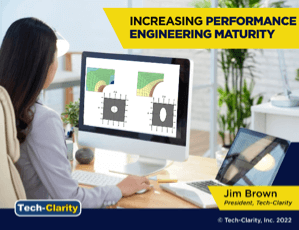 How can increasing performance engineering maturity help manufacturers ensure they’ve fully optimized equipment performance? How does “shifting left” with simulation and closed-loop feedback help improve performance without compromising project due dates?
Please enjoy the summary* below. For the full research, please visit our sponsor Siemens (registration required).
How can increasing performance engineering maturity help manufacturers ensure they’ve fully optimized equipment performance? How does “shifting left” with simulation and closed-loop feedback help improve performance without compromising project due dates?
Please enjoy the summary* below. For the full research, please visit our sponsor Siemens (registration required).
Table of Contents
- The Performance Engineering Imperative
- Predicting Equipment Performance Virtually
- Create Holistic Equipment Models
- Predict Performance Through Simulation
- Improve Predictive Through Testing
- Improve Predictions with Field Data
- Improve Equipment Performance with Lower Overhead
- Acknowledgments
The Performance Engineering Imperative
Increasing Market Demands Engineers need to continuously improve and optimize equipment designs. Global competition is intense and the performance bar is constantly being raised. Equipment must meet increasingly challenging market demands for weight, fuel efficiency, sustainability, regulatory compliance, and more connected operations environments while still meeting aggressive time-to-market requirements. Some manufacturers are also evolving to new business models, such as product-as-a-service (PaaS), where profitability relies directly on equipment performance in the field. Increasing Product Complexity
Harder targets are made even more challenging because of increased product complexity. Equipment is more electrified, autonomous, connected, and configurable than ever. Companies must adopt systems, and systems-of-systems, engineering approaches. At the same time, manufacturers are adopting new materials such as composites, advanced manufacturing methods including additive manufacturing, and innovative design techniques such as generative design. These innovations create designs that can’t be easily validated using historical tests and product performance, demanding new approaches.
Simulation is Critical, but not Enough
Computer Aided Engineering (CAE) has clearly helped manufacturers overcome complexity and reach new performance levels. But the time has come to explore new digital technologies. Traditional simulation benefits may no longer meet the demands of digitalization trends.
In order to get products right the first time, and to “shift left” optimization to get to the best design faster, companies have to be able to predict equipment performance in a variety of facets, including:
Increasing Product Complexity
Harder targets are made even more challenging because of increased product complexity. Equipment is more electrified, autonomous, connected, and configurable than ever. Companies must adopt systems, and systems-of-systems, engineering approaches. At the same time, manufacturers are adopting new materials such as composites, advanced manufacturing methods including additive manufacturing, and innovative design techniques such as generative design. These innovations create designs that can’t be easily validated using historical tests and product performance, demanding new approaches.
Simulation is Critical, but not Enough
Computer Aided Engineering (CAE) has clearly helped manufacturers overcome complexity and reach new performance levels. But the time has come to explore new digital technologies. Traditional simulation benefits may no longer meet the demands of digitalization trends.
In order to get products right the first time, and to “shift left” optimization to get to the best design faster, companies have to be able to predict equipment performance in a variety of facets, including:
- Holistically by managing tradeoffs
- Accurately by gaining a meaningful understanding of the impact of engineering decisions
- Efficiently by making it feasible to optimize early and often throughout the design process
Improve Equipment Performance with Lower Overhead
Adopt Predictive Performance Engineering Like predictive service, which has proven value, predictive performance engineering has tremendous business potential. The approach allows companies to unlock new levels of innovation and performance while simultaneously improving efficiency and reducing cost. Manufacturers that improve performance engineering maturity will likely be able to develop more innovative, high-performance equipment at a lower cost. At the same time, they will no longer have to trade off hitting their certification and market readiness objectives in order to reach performance goals. Improve Performance Engineering Maturity Companies can increase performance engineering maturity by improving the following four processes:- Create holistic equipment models
- Predict performance through simulation
- Improve predictions through testing
- Improve predictions with field data
 What do industry experts and your manufacturing peers have to say about smart manufacturing? Join this live event on April 28th in Cleveland, Ohio to find out.
Our own Jim Brown will keynote the conference, sharing his views on how manufacturers can “bounce forward” from recent disruptions with smart manufacturing solutions. Then you’ll hear from a host of great speakers and have the opportunity to join roundtable sessions to learn from the presenters, panelists, and peers alike.
And if that’s not enough, the Cleveland Manufacturing event starts with lunch and is followed up with a happy hour. Join us to share your experience and learn from others.
List of speakers:
What do industry experts and your manufacturing peers have to say about smart manufacturing? Join this live event on April 28th in Cleveland, Ohio to find out.
Our own Jim Brown will keynote the conference, sharing his views on how manufacturers can “bounce forward” from recent disruptions with smart manufacturing solutions. Then you’ll hear from a host of great speakers and have the opportunity to join roundtable sessions to learn from the presenters, panelists, and peers alike.
And if that’s not enough, the Cleveland Manufacturing event starts with lunch and is followed up with a happy hour. Join us to share your experience and learn from others.
List of speakers:
- Jim Brown (keynote) - President and Founder, Tech-Clarity
- Bouncing Forward with Smart Manufacturing Solutions
- Mike Yost - Creator project IGBYS
- Technology Will Not Save Manufacturing. Manufacturers Will
- Jake Hall - Business Development Manager, Feyen Zylstra
- How to Attract the Next Workforce with Automation and Digital Solutions
- John Keyes - Director, Feyen Zylstra
- Sustainability & The Smart Manufacturing Imperative
- Kausik Dasgupta - Vice President of Technology, FactoryEye
- Data Lakes - Why Should I Care? They are not a nice-to-have but a must-have for manufacturers
- Jane Biddle - Moderator, FactoryEye
- Terri Ghio - President, North America, FactoryEye
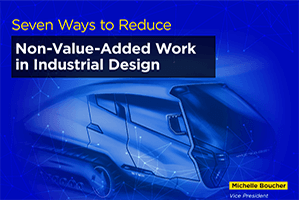 How much of your industrial design work can be leveraged during detail design? Could your products be even better if you had more time to get concepts right by reducing non-value-added work?
An overwhelming 76% of manufacturers agree that spending more time on concept and industrial design would improve products. Unfortunately, industrial designers waste significant time on non-value-added work, which holds them back. Read our eBook, Seven Ways to Reduce Non-Valued-Added Work in Industrial Design to learn how to reduce wasted effort so that Industrial Designs can work more efficiently to help your company develop even better products. You will also learn way to improve collaboration between industrial designers and design engineers.
Please enjoy the summary below.* For the full report, please visit our sponsor Dassault Systèmes SOLIDWORKS (registration required).
For related research, please read our eBook, How to Reduce Non-Valued-Added Work in Engineering to learn more about how to reduce wasted effort and increase focus on value-added engineering and innovation work.
How much of your industrial design work can be leveraged during detail design? Could your products be even better if you had more time to get concepts right by reducing non-value-added work?
An overwhelming 76% of manufacturers agree that spending more time on concept and industrial design would improve products. Unfortunately, industrial designers waste significant time on non-value-added work, which holds them back. Read our eBook, Seven Ways to Reduce Non-Valued-Added Work in Industrial Design to learn how to reduce wasted effort so that Industrial Designs can work more efficiently to help your company develop even better products. You will also learn way to improve collaboration between industrial designers and design engineers.
Please enjoy the summary below.* For the full report, please visit our sponsor Dassault Systèmes SOLIDWORKS (registration required).
For related research, please read our eBook, How to Reduce Non-Valued-Added Work in Engineering to learn more about how to reduce wasted effort and increase focus on value-added engineering and innovation work.
Table of Contents
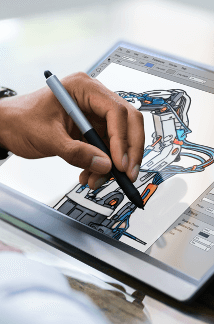 Executive Summary
Executive Summary- Importance of Concept and Industrial Design
- Identifying Top Performers
- Strategies to Reduce Non-Value-Added Work
- 1. Improve Efficiency with a Single Solution
- 2. Support Reuse by Leveraging the Concept during Detail Design
- 3. Enable Easy Iterations
- 4. Facilitate Internal Feedback
- 5. Solicit Customer Feedback
- 6. Select an Ideal Solution
- 7. Tie it Together on a Platform
- Recommendations
- About the Research
- Acknowledgments
Executive Summary
Reducing Non-Value-Added Work An overwhelming 76% of manufacturers agree that spending more time on concept and industrial design would improve products. Unfortunately, industrial designers waste significant time on non-value-added work, which holds them back. Further, detail designers waste even more time recreating industrial design details. Reducing this non-value-added work could help a company get to market faster, optimize profitability, maximize revenue potential, and offer more competitive offerings. Interestingly, 99% say that technology should play a role in limiting this non-value-added work. Moreover, the research identified key ways technology can help. Seven Practices This report reveals seven practices that will reduce non-value-added work in industrial design:- Use a single solution to support industrial and detail design.
- Leverage more of the concept model during detail design.
- Streamline design iterations between industrial and detail design.
- Facilitate internal feedback with more efficient design reviews.
- Involve customers as early as possible.
- Ensure your solution meets the unique needs of industrial designers.
- Tie everything together with a cloud platform.
- 95% of Top Performers who use a single solution for both industrial and detail design rate their remodeling process as ‘excellent’ or ‘very good.’
- 71% of industrial designers say it would save time if customers could provide more feedback early on.
- Industrial designers identify the top quality of an ideal industrial design solution as one that supports both subdivision and parametric modeling.
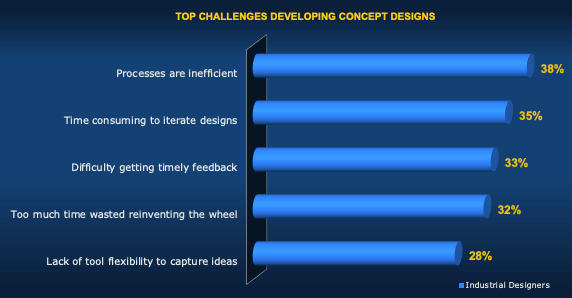
Recommendations
Recommendations and Next Steps Based on industry experience and research for this report, Tech-Clarity offers the following recommendations:- Investments to improve the efficiency of industrial and concept design can offer a competitive advantage.
- Consider a single solution to support industrial and detail design so that rather than wasting time importing, exporting, fixing, and recreating data, designers can spend more time on critical design work.
- Ensure that detail designers can reuse as much of the concept design as possible. Reinventing the wheel by recreating design details already in the concept model wastes their time. Instead, they could use that time to innovate, improve product quality, or beat deadlines to get to market faster.
- Reduce barriers to iterations so industrial and detail designers can remodel the design as needed to improve upon ideas, implement engineering changes, or fix manufacturability issues. When their work is siloed, iterations involve importing and exporting data, which wastes hours.
- Improve the timeliness of internal feedback with more streamlined ways to solicit feedback and more efficient design reviews. Real-time visibility to design progress on a single, integrated design collaboration platform can improve collaboration to efficiently collect feedback.
- Involve customers as early as possible to provide feedback to help ensure your product aligns with customer needs.
- When selecting a single solution for industrial and detail design, ensure it supports both subdivision and parametric modeling.
- Tie everything together with a cloud platform so that you have the infrastructure to support better collaboration, and designers can access the software capabilities they need on the hardware they prefer.
 What makes it so difficult to manage operations data and achieve AI success in batch process industries? There are many valid answers, and it’s crucial to address them all. In this white paper, we explore special issues around mindset, complexity, multiple disciplines, and a variety of dispersed data. We also address how these batch process issues intersect with the five main facets of data management.
Click here for the full report (no registration required), courtesy of our sponsor, Quartic.ai.
What makes it so difficult to manage operations data and achieve AI success in batch process industries? There are many valid answers, and it’s crucial to address them all. In this white paper, we explore special issues around mindset, complexity, multiple disciplines, and a variety of dispersed data. We also address how these batch process issues intersect with the five main facets of data management.
Click here for the full report (no registration required), courtesy of our sponsor, Quartic.ai.
Table of Contents
- Executive Overview
- Taking Action to Get Value from a Flood of Data
- Building a Data Foundation
- Facet 1: Data Collection and Extraction
- Facet 2: Data Harmonization and Storage
- Facet 3: Contextualization
- Facet 4: Analytics
- Facet 5: Applications
- Consider a Complete Platform
- Recommendations
- References
- About the Author
Executive Overview
Urgency has never been greater for makers of biopharmaceuticals and consumer products to be faster, more efficient, and more confident in serving customers. As experts retire and regulators increase pressure, this need grows. Companies are look to Industry 4.0 technologies for digitalization and ideally predictive approaches to improve performance. At the heart of whether they succeed is their ability to manage operations data effectively. Many companies are experimenting with new technologies, particularly advanced analytics such as machine learning (ML), but most cannot build scalable and sustainable solutions. This raises a host of questions:- Why are so many projects failing to meet expectations?
- How can we get past proofs of concept (PoCs) and move on to enterprise-wide digital transformation?
- Beyond failing fast, can we finally move on from those experiments and succeed?
- Have a mix of digital and non-digital assets
- Operations data vary in provenance and usage
- Have to satisfy a wide variety of stakeholders by discipline and level in the organization
- Have many types, formats, cadences, and volumes of data to bring together: from operational technology (OT), IT, and business partners such as suppliers
- Need to contextualize a set of varied data streams differently for various stakeholders, such as asset, product, process, or time
- There are thousands of use cases and applications to satisfy, and even in a moderate-sized organization, many of these situations arise unexpectedly

Recommendations
Based on industry experience and research for this report, Tech-Clarity offers the following recommendations:- Focus on Value: Set your sights on how to stay focused on optimizing our business, allowing solution providers to deliver the industrial data management platform.
- Map It: Operations data management is a journey each piece building on the next. It pays to map it out in advance and get prerequisites in place at each step.
- Set Scope: Set small goals and craft projects that deliver business value and some piece of the foundation simultaneously. More than a one-off PoC, but not ”boiling the ocean,” and always with a long-term view.
- Commit Big: Don’t expect a silver bullet – this is hard work, just as ISA88 and 95 were; each facet is likely to be that much work
- Communicate: Educate everyone that getting to actionable insights requires all five facets of the data foundation to be robust and tightly integrated.
- Multi-level: Realize that this data foundation layer must include edge, fog, site, enterprise, and ecosystem layers.
- Ask Hard Questions: Don’t assume anything internally or with solution providers. Many projects make significant gains just in mapping the current reality and spotting issues to address immediately, even without new technology.
- Involve All: Form a team for the initiative with all stakeholders – IT and OT, production, quality, maintenance, site-level, enterprise-level.
- Partner: Don’t plan to do all the work yourself. You probably can’t afford the time, money, and problems of DIY experimentation.
- Test the Partner: If an industrial data management platform provider seems like a good fit, craft a proof of concept (PoC) in the context of a larger long-term strategy.
- Gain Benefits: Rather than fail fast, seek to succeed relatively quickly in getting to the next step with industrial data management
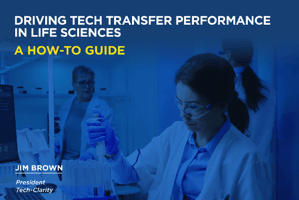 Our research shows that companies with the highest tech transfer performance digitalize their tech transfer data and processes. But what does digital tech transfer look like, and how do you get there? This how-to guide shows life sciences companies the way.
Please enjoy the summary* below. For the full research, please visit our sponsor Dassault Systèmes (registration required).
Our research shows that companies with the highest tech transfer performance digitalize their tech transfer data and processes. But what does digital tech transfer look like, and how do you get there? This how-to guide shows life sciences companies the way.
Please enjoy the summary* below. For the full research, please visit our sponsor Dassault Systèmes (registration required).
Table of Contents
- Why Digitalize Tech Transfer?
- Digitalize Data
- Automate Data Gathering
- Integrate Data and Processes
- Expand Collaboration
- Gain and Leverage Knowledge
- Adopt Best Practices to Improve Tech Transfer
- About the Research
- Acknowledgments
Why Digitalize Tech Transfer?
Tech Transfer Objectives The World Health Organization explains that “Technology transfer can be considered successful if there is documented evidence that the RU (receiving unit) can routinely reproduce the transferred product, process, or method against a predefined set of specifications as agreed with the SU (sending unit).” That may be true, but is that enough to define success from a business perspective? Companies have to be able to not just effectively transfer technology from early discovery to manufacturing. They have to do so efficiently, with quality, to compete. Identifying Best Practices Our report, Digitalizing Tech Transfer, benchmarked companies on their:- Speed in achieving steady-state, full-rate production
- Yield and product quality in early production, and
- Their overhead cost to support tech transfer.
 This guide identifies key steps life sciences companies must take to implement best practices and improve tech transfer performance:
This guide identifies key steps life sciences companies must take to implement best practices and improve tech transfer performance:
- Digitalize Data
- Automate Data Gathering
- Integrate Data and Processes
- Expand Collaboration
- Gain and Leverage Knowledge
Adopt Best Practices to Improve Tech Transfer
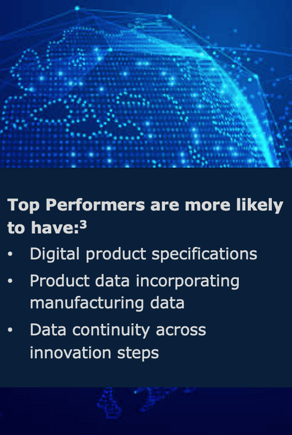 Take the Time to Get it Right
It’s time for life sciences companies to digitalize tech transfer. Tech transfer success for analytical and manufacturing methods is critical to business success and profitability in the life sciences industry. But tech transfer success is multi-dimensional. Tech transfer requires agility, but speed without quality isn’t enough.1 Getting tech transfer projects right the first time helps save money and get to market faster.
Improving Tech Transfer through Digitalization
Digitalizing tech transfer processes and data is fundamental to improving tech transfer success and broader continuous improvement. The following steps can further drive best practices and performance improvements:
Take the Time to Get it Right
It’s time for life sciences companies to digitalize tech transfer. Tech transfer success for analytical and manufacturing methods is critical to business success and profitability in the life sciences industry. But tech transfer success is multi-dimensional. Tech transfer requires agility, but speed without quality isn’t enough.1 Getting tech transfer projects right the first time helps save money and get to market faster.
Improving Tech Transfer through Digitalization
Digitalizing tech transfer processes and data is fundamental to improving tech transfer success and broader continuous improvement. The following steps can further drive best practices and performance improvements:
- Digitalize Data
- Automate Data Gathering
- Integrate Data and Processes
- Expand Collaboration
- Gain and Capture Knowledge
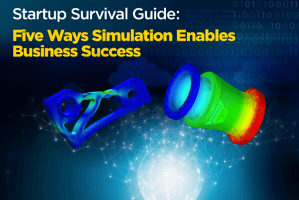 How can startup companies improve their chances of success?
Our Startup Survival Guide reveals both how and why simulation can provide startups an edge to launch a successful product. As part of a cloud platform, CAE can also be more accessible to startups.
Please enjoy the summary* below. For the full research, please visit our sponsor Dassault Systèmes (registration required).
For more information on simulation, see our related research How to Survive and Win New Markets By Getting Even More Value from Simulation and How to Engineer High-Performing, Quality Products without Extra Cost.
How can startup companies improve their chances of success?
Our Startup Survival Guide reveals both how and why simulation can provide startups an edge to launch a successful product. As part of a cloud platform, CAE can also be more accessible to startups.
Please enjoy the summary* below. For the full research, please visit our sponsor Dassault Systèmes (registration required).
For more information on simulation, see our related research How to Survive and Win New Markets By Getting Even More Value from Simulation and How to Engineer High-Performing, Quality Products without Extra Cost.
Executive Summary
Endless Possibilities Recessions and the years following them often mark the birth of new businesses, making this a very exciting time for entrepreneurs. With expanded options for funding and opportunities for new technologies to enable innovation, there are endless possibilities for startups. As a result, we are now seeing more successful new companies than ever before. Unfortunately, for every success story, there are even more startups that do not make it. It is hard to start a new business from scratch as funding is limited, and competing with more established companies that have more resources can be challenging. The good news is that for many, modern software tools are closing the resource gap. New software solutions, supported by a modern infrastructure, allow even the smallest businesses access to resources that previously were available only to large companies with deep pockets. Cloud-Based Simulation A cloud-based simulation software platform is one such tool. Simulation software allows you to evaluate more options in less time, optimize the design, and catch problems early in the design process. In addition, startups can avoid significant upfront investments in software and hardware by using a cloud-based solution. Plus, companies do not need to worry about investing precious resources in an IT department to implement and maintain it. This Report This report discusses the most common reasons startups fail and explains how a cloud-based simulation platform can help. By taking advantage of the technology, it can allow you to:- Access more funding
- Improve profitability
- Get the product right
- Validate market needs
- Leverage the right talent

Table of Contents
- The Opportunities for Startups
- 1. Access More Funding
- 2. Improve Profitability
- 3. Get the Product Right
- 4. Validate Market Needs
- 5. Leverage the Right Talent
- Recommendations
- Acknowledgments
Recommendations
Recommendations and Next Steps Based on industry experience and research for this report, Tech-Clarity offers the following recommendations:
Based on industry experience and research for this report, Tech-Clarity offers the following recommendations:
- Use simulation to demonstrate progress to investors to help justify additional funding.
- Leverage a cloud platform to preserve capital by avoiding high upfront costs for software licenses and investments in high-end hardware.
- Optimize your product for quality and cost to maximize profitability and allow you to price your product competitively.
- Support rapid iterations with simulation to develop a more innovative, competitive product.
- Take advantage of simulation in the cloud to validate your product early and often with potential customers to verify it will meet market needs.
- Tap into additional expertise as needed with a simulation cloud platform that will provide flexibility to easily collaborate with third parties.
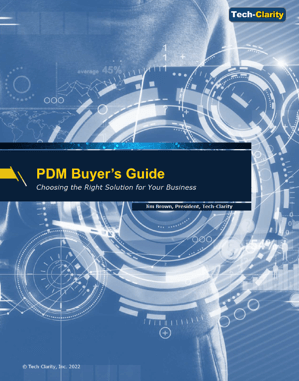 How can you ensure that you choose the right PDM software and partner for your business? The right system serves as the backbone for digital transformation and impacts productivity, product success, and profitability. How can you make sure to get it right?
Please enjoy the summary* below. For the full research, please visit our sponsor PTC (registration required).
How can you ensure that you choose the right PDM software and partner for your business? The right system serves as the backbone for digital transformation and impacts productivity, product success, and profitability. How can you make sure to get it right?
Please enjoy the summary* below. For the full research, please visit our sponsor PTC (registration required).
Table of Contents
- Introducing the PDM Buyer's Guide
- Using the PDM Buyer's Guide
- Analyze PDM Capabilities: Control
- Analyze PDM Capabilities: Access
- Analyze PDM Capabilities: Share
- Assess Service Requirements
- Service Requirements: Implementation
- Service Requirements: User Adoption
- Service Requirements: Support
- Consider Vendor Requirements
- Identify Unique Company Needs
- Support the Digital Enterprise
- Conclusion
- Recommendations
- Acknowledgments
Introducing the PDM Buyer's Guide
 Product Data Management (PDM) is an important tool to help manufacturers overcome the complexities of designing, developing, producing, and supporting today’s products and product development processes. Manual and ad-hoc approaches such as shared folders, cloud storage, and hard drives are simply not effective solutions to manage critical, complex product information. These approaches may work for very small organizations, but quickly falter as organizations grow and must share information beyond a few core engineers. These techniques also fail to manage data relationships and complex file structures common to 3D CAD systems. PDM systems are purpose-built to address these issues.
PDM is a structured, collaborative solution that helps manufacturers control, access, and share crucial product data. Selecting the right PDM system can have a large impact on productivity, product success, and profitability. How can you ensure that you choose the right software and partner for your business?
Purpose of the Guide
The PDM Buyer’s Guide is not intended to provide an all-encompassing requirements list. Instead, it covers the high points that manufacturers should look for in a PDM system. Think of this as a “PDM litmus test” to see if a solution is a good high-level fit for your business before spending significant time and effort analyzing detailed features and functions.
Consider Broader Requirements
Although the checklists focus only on PDM requirements, it’s important to consider more than your current needs when choosing a system. Many companies eventually want to grow beyond basic PDM to a more complete PDM system. These more advanced capabilities are covered in our Expanding Beyond Your Outgrown PDM System Buyer’s Guide. Other companies may start with PDM and evolve through a maturity process to a more complete Product Lifecycle Management (PLM) environment. PLM extends the core PDM foundation to support more product development and engineering processes, manage a richer view of products, include more people in product development, and support processes further upstream and downstream from Engineering in the product lifecycle (Figure 1).
Product Data Management (PDM) is an important tool to help manufacturers overcome the complexities of designing, developing, producing, and supporting today’s products and product development processes. Manual and ad-hoc approaches such as shared folders, cloud storage, and hard drives are simply not effective solutions to manage critical, complex product information. These approaches may work for very small organizations, but quickly falter as organizations grow and must share information beyond a few core engineers. These techniques also fail to manage data relationships and complex file structures common to 3D CAD systems. PDM systems are purpose-built to address these issues.
PDM is a structured, collaborative solution that helps manufacturers control, access, and share crucial product data. Selecting the right PDM system can have a large impact on productivity, product success, and profitability. How can you ensure that you choose the right software and partner for your business?
Purpose of the Guide
The PDM Buyer’s Guide is not intended to provide an all-encompassing requirements list. Instead, it covers the high points that manufacturers should look for in a PDM system. Think of this as a “PDM litmus test” to see if a solution is a good high-level fit for your business before spending significant time and effort analyzing detailed features and functions.
Consider Broader Requirements
Although the checklists focus only on PDM requirements, it’s important to consider more than your current needs when choosing a system. Many companies eventually want to grow beyond basic PDM to a more complete PDM system. These more advanced capabilities are covered in our Expanding Beyond Your Outgrown PDM System Buyer’s Guide. Other companies may start with PDM and evolve through a maturity process to a more complete Product Lifecycle Management (PLM) environment. PLM extends the core PDM foundation to support more product development and engineering processes, manage a richer view of products, include more people in product development, and support processes further upstream and downstream from Engineering in the product lifecycle (Figure 1).

Conclusion
Adopt Common Requirements for PDM PDM helps manufacturers address complexity and improve business performance. When evaluating PDM, manufacturers need to take into account:- Product requirements
- Implementation, adoption, and support requirements
- Vendor / business requirements
- Special requirements based on company size (particularly for very small or very large organizations)
- Special considerations to meet industry needs
- Future requirements as the manufacturing industry continues to digitally transform
Recommendations
Based on industry experience and research for this report, Tech-Clarity offers the following recommendations:- Identify and weigh PDM requirements based on company needs, company size, industry, and any unique company needs
- Use high-level requirements such as the ones in this guide to evaluate solutions based on business fit before engaging in detailed, technical evaluations
- Consider using the cloud or managed services solutions for companies that wish to move quickly, have limited IT resources, want to reduce overhead, or want to modernize their IT infrastructure
- Take user adoption into account, including simplified access, increased visualization, and task-specific apps for non-engineering resources
- Take into account long-term business and process growth needs including digital transformation, AR / VR, and IoT initiatives
- Consider the potential to expand to a more capable extended PDM or PLM system, but start small and get value along the way during implementation
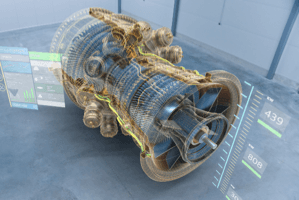 How do you manage system family engineering?
How do you manage system family engineering?
Table of Contents
- New Semiconductor Imperatives
- Topic: Skyrocketing Demand Puts Pressure on Fabs
- Innovation Issues
- Meeting Demand
- Processing Challenges
- Progress Matters
- Quality Demands
- Empowering the Workforce
- IT Overwhelm
- Streamlining Information Systems
- MES Reimagined
- Reimagine and Reinvest in MES
- Acknowledgements
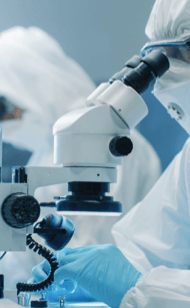 New Semiconductor Imperatives
New Semiconductor Imperatives
Keeping up with rising demand, product portfolio growth, complex products, processing mix, and new application requirements creates tremendous challenges for semiconductor makers. Companies must increase their pace of both learning and ramping up new products and processes.
Production operations are a pinch point. To handle new demands, companies must optimize further. Thus, it is imperative to reimagine the manufacturing execution system (MES) for semiconductor to meet today’s needs.
MES must expand beyond work-in-process (WIP) and track and trace to become the data platform for production innovation, change, and efficiency. All types of facilities face this need, and modern MES can serve silicon, R&D, front-end fabs, back end, and even module production. While no longer isolated, front-end fabs face particular challenges and urgency due to their array of advanced capabilities.
Reimagine and Reinvest in MES
Expect More in Software Over the past several years, fab processes have changed, and your Manufacturing IT must as well. Open your minds to reimagine what MES is and does. Evaluate MES against customer requirements and strategic business needs. As this paper describes, modern MES solutions go far beyond track and trace and WIP management to support advanced semiconductor processing capabilities. Evaluate the Need Most semiconductor fabs have a vast “hidden fab” where workarounds have become the norm. To understand that count how many systems you use to support fab operations today measure how much time, effort, and energy your team spends finding and consolidating data for day-to-day operations understand how much time the Manufacturing IT team spends maintaining and customizing the MES. If you’re dissatisfied with the answers, look for software that supports your fab’s advanced capabilities. Reinvest in MES Push MES providers to get what you need. Some specifics you might need are in Figure 5. Beyond specifics, you need a smooth and coherent flow of data in the fab and into the enterprise. Speed of learning all you need to ramp up for NPI and continue improving yield and serving the market opportunities lies in that manufacturing data management. Investing is urgent – you can’t be as resilient nor as profitable as you want without data that’s in context and ready to use. *This summary is an abbreviated version of the research and does not contain the full content. Please visit our sponsor Critical Manufacturing for the full research (registration required). If you have difficulty obtaining a copy of the report, please contact us. [post_title] => Reimagining Semiconductor MES (eBook) [post_excerpt] => [post_status] => publish [comment_status] => open [ping_status] => open [post_password] => [post_name] => semiconductor-mes [to_ping] => [pinged] => [post_modified] => 2022-11-14 22:28:26 [post_modified_gmt] => 2022-11-15 03:28:26 [post_content_filtered] => [post_parent] => 0 [guid] => https://tech-clarity.com/?p=11059 [menu_order] => 0 [post_type] => post [post_mime_type] => [comment_count] => 0 [filter] => raw ) [13] => WP_Post Object ( [ID] => 11049 [post_author] => 2 [post_date] => 2022-01-12 16:01:14 [post_date_gmt] => 2022-01-12 21:01:14 [post_content] =>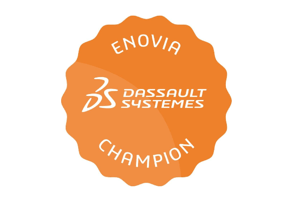 I had the pleasure of joining Dassault Systemes’ special ENOVIA Champions Advisory Board Meeting at the end of 2021. It was a unique learning opportunity because the Champions are a global community of people that use or support ENOVIA and the 3DEXPERIENCE platform at their companies. It was also nice to see some industry friends at the meeting.
I was impressed by the group’s Program activities and participation. The awards presented at the event reflect significant community engagement. The participants are active and not only have a great networking opportunity, they are empowered to learn, engage and influence the ENOVIA leadership team to help drive solution strategy to benefit their companies. Individuals who apply to the ENOVIA Champions Program represent a wide variety of Dassault Systemes customers across virtually every industry from across the globe.
I was also pleased to see the level of organization and support provided by Dassault Systemes. Its logistics support makes participation in the sessions and other related community activities relatively easy. The involvement by the Dassault Systems ENOVIA team, including executive participation by ENOVIA CEO Stéphane Declee and Program leadership by Susan Lenzi, demonstrates that Dassault Systemes’ values interaction with its users. This program is a good example of a highly, mutually-beneficial vendor–customer relationship.
I had the pleasure of joining Dassault Systemes’ special ENOVIA Champions Advisory Board Meeting at the end of 2021. It was a unique learning opportunity because the Champions are a global community of people that use or support ENOVIA and the 3DEXPERIENCE platform at their companies. It was also nice to see some industry friends at the meeting.
I was impressed by the group’s Program activities and participation. The awards presented at the event reflect significant community engagement. The participants are active and not only have a great networking opportunity, they are empowered to learn, engage and influence the ENOVIA leadership team to help drive solution strategy to benefit their companies. Individuals who apply to the ENOVIA Champions Program represent a wide variety of Dassault Systemes customers across virtually every industry from across the globe.
I was also pleased to see the level of organization and support provided by Dassault Systemes. Its logistics support makes participation in the sessions and other related community activities relatively easy. The involvement by the Dassault Systems ENOVIA team, including executive participation by ENOVIA CEO Stéphane Declee and Program leadership by Susan Lenzi, demonstrates that Dassault Systemes’ values interaction with its users. This program is a good example of a highly, mutually-beneficial vendor–customer relationship.
My Message to ENOVIA Champions
I shared two key things from our research:- The business imperative of digital transformation for manufacturers
- How PLM supports digital transformation at the highest level while driving engineering efficiency gains
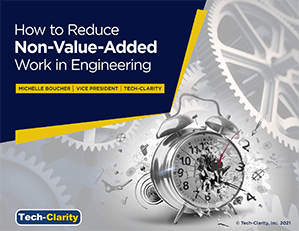 Did you know engineers waste so much time on non-value-added work, they only spend about 54% of their time actually designing? How can you prevent them from wasting too much time on non-value-added work?
Our research uncovered some significant engineering inefficiencies that contribute to this including:
Did you know engineers waste so much time on non-value-added work, they only spend about 54% of their time actually designing? How can you prevent them from wasting too much time on non-value-added work?
Our research uncovered some significant engineering inefficiencies that contribute to this including:
- 29% percent of engineering time is spent working with outdated information
- After implementing a change, depending on product complexity, it takes 4.7 to 10.3 days for to get updated data to the entire team
- 94% say they need updated data faster than they currently get it
The Value of Engineering Time
Engineering Time Is a Valuable Asset How can you reduce non-value-added engineering work? Engineers are under constant pressure to meet tight deadlines. They need time to balance quality, cost, and performance criteria as well as to innovate and solve problems. Unfortunately, they waste too much of their valuable time on non-value-added work. Imagine the opportunities if engineers could reduce those tedious activities to focus more energy on engineering work that leads to better designs. This Research Based on a survey of over 220 manufacturers, this research study examines how engineers spend their time. It identifies time-consuming activities that waste time and present opportunities for improvement. This research is an updated look at a study of 248 manufacturers conducted in 2014 and examines how trends have evolved over the last seven years.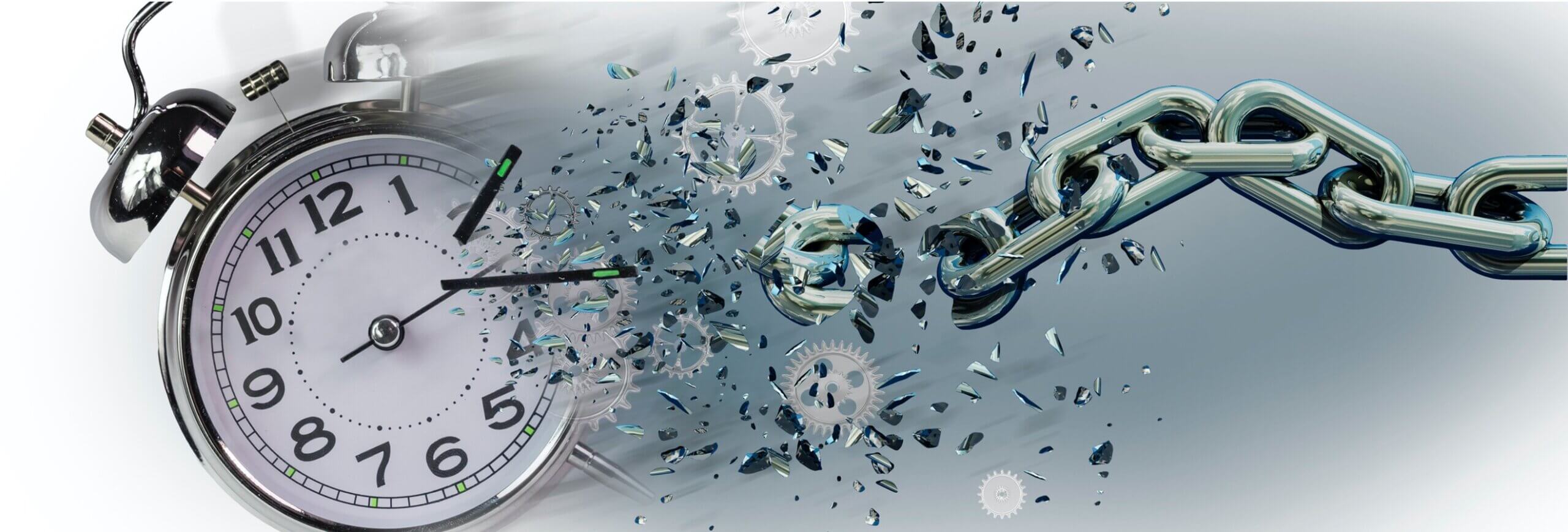
Table of Contents
- Executive Summary
- Identify Bottlenecks
- Assess Non-Value-Added-Time
- Preparing Data for Others
- Business Value of Eliminating Non-Value-Added Work
- Recognize the Time Required for Check-ins
- Outdated Information Impacts Engineering Changes
- The Impact of Outdated Information on Collaboration
- Identifying the Top Performers
- Strategies to Improve Efficiency
- Technology as a Collaboration Solution
- Consider the Security Risks of Email
- The Benefits of Real-Time Data Updates
- Recommendations
- About the Research
- Acknowledgments
Executive Overview
Engineering is Key to Competitive Differentiation Today's market is so competitive; it is hard to stand out. To be successful, companies must empower their engineering teams to differentiate products on innovation, quality, performance, and cost. While finding the time to balance those criteria is challenging, many current processes make it even harder. Consequently, engineers report they waste a third of their time on non-value-added work, which is consistent with what we saw in 2014. Worse, 29% of their time is spent working with outdated information. It has become an even bigger problem than it was in 2014 when engineers reported working with outdated data 20% of the time. Unfortunately, this leads to even more wasted effort and rework. Further, companies anticipate that going forward, 43% of engineering work will be done in flexible, work anywhere environments. This will only add to the complexity of engineering team environments, creating even more risk for outdated information and additional non-value-added work. Engineers need new ways of working. One way companies can improve this situation is to provide engineers with real-time access to design data, in the right context. This keeps the data up-to-date and at their fingertips. The result should be increased engineering bandwidth, allowing more time to focus on making products more competitive. This approach also improves the growing need to improve collaboration beyond design engineers, with 83% saying it would be helpful if design data could be shared more easily with analysts and 86% wanting to share design data more easily with manufacturing. Determining Best Practices To determine best practices for accessing design information, Tech-Clarity analyzed survey responses from over 220 manufacturers to understand how they manage data, communicate engineering changes, and collaborate with both internal and external development team members. The research shows that to improve efficiency, companies who are most successful, Top Performers, are 56% more likely than their lesser performing competitors to enable real-time access to design information and 52% more likely to adopt a platform of integrated engineering tools.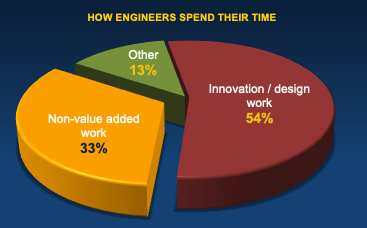 What Can You Learn from This Research?
This report explores best practices for streamlining access to design data in real-time. It also exposes some challenges manufacturers should be aware of as they strive to maintain a competitive edge in today's complex and cutthroat environment. The report also reveals how manufacturers can plan for a modern design environment that will support them through the 2020s.
What Can You Learn from This Research?
This report explores best practices for streamlining access to design data in real-time. It also exposes some challenges manufacturers should be aware of as they strive to maintain a competitive edge in today's complex and cutthroat environment. The report also reveals how manufacturers can plan for a modern design environment that will support them through the 2020s.
Recommendations
Recommendations and Next Steps Based on industry experience and research for this report, Tech-Clarity offers the following recommendations:- Understand how engineers spend their time and improve processes and collaboration to minimize time wasted on non-value-added work.
- Consider solutions such as PLM or PDM to centralize design information and support change management and collaboration.
- Evaluate options to design components in the context of the overall assembly. This will improve collaboration, make it easier to identify interdependencies between components, and provide a better understanding of the impact of changes.
- Consider technologies that enable real-time updates to keep CAD data up-to-date while minimizing or eliminating check-in times.
- Establish means for secure, real-time collaboration with both internal teams and third parties to minimize delays in getting updated CAD data from them and assuring your IP is protected.
 How can manufacturers succeed in the face of uncertainty that creates new needs for decision-makers at every level? Read (Re)Gaining Control in Manufacturing: The Right ERP can Ensure Uncertainty Doesn’t Restrict Your Growth to learn how and hear from three executives who have done it.
How can manufacturers succeed in the face of uncertainty that creates new needs for decision-makers at every level? Read (Re)Gaining Control in Manufacturing: The Right ERP can Ensure Uncertainty Doesn’t Restrict Your Growth to learn how and hear from three executives who have done it.
- Why the right fit modern, comprehensive, and factory-capable ERP opens up visibility and control.
- Ways consistent information maintains the advantage of being agile to pivot confidently as the company grows.
- How to impress customers and prospects by delivering detailed information with every product at no additional cost or effort.
Table of Contents
- Responding in an Uncertain World
- The Growth Conundrum
- Expanding the Advantage
- Digital Ways of Working
- Digital Manufacturing in Reach
- What to Look for in ERP Software
- Choosing an ERP Partner
- Executives on ERP
- Control the Business
Executive Summary
 Given the ever-shifting realities of today’s manufacturing environment, how can business leaders (re)gain control? The answer is to have an enterprise resources planning system (ERP) that fits and spans their business. Many companies are finding their current ways of working restrict their ability to respond. These companies are at an inflection point and will benefit from seeking out and investing in ERP that enables instant yet profitable decisions using complete information from across their business and plant operations.
Given the ever-shifting realities of today’s manufacturing environment, how can business leaders (re)gain control? The answer is to have an enterprise resources planning system (ERP) that fits and spans their business. Many companies are finding their current ways of working restrict their ability to respond. These companies are at an inflection point and will benefit from seeking out and investing in ERP that enables instant yet profitable decisions using complete information from across their business and plant operations.
Responding in an Uncertain World
Uncertainty Defines the Market No one doubts that their environment is uncertain. Nearly every business is feeling the impact of world affairs, including the COVID-19 pandemic, natural disasters, political upheaval, trade wars, and tariffs. Raising Key Questions As a result, manufacturers face a plethora of market questions.- Demand – Will customer orders be up or down or swing wildly between the two?
- Supply – Will raw materials to meet that demand be available now or later or not?
- Labor – Can the company hire and retain employees with the needed skills and experience in the face of an enormous talent shortage nearly everywhere?
- Sustainability – Can the business keep up with ever-changing and more stringent government and customer requirements?
Control the Business
Despite Uncertainty Uncertainty is a feature of the “new normal;” don’t expect it to go away. Digital is a reality every manufacturer must keep up with, especially since competitors are. Today’s manufacturing-centric ERP allows you to gain visibility, control, and analyze not just past performance but likely future scenarios. Because of these benefits, 50% of companies are planning or actively investing in ERP3. People Matter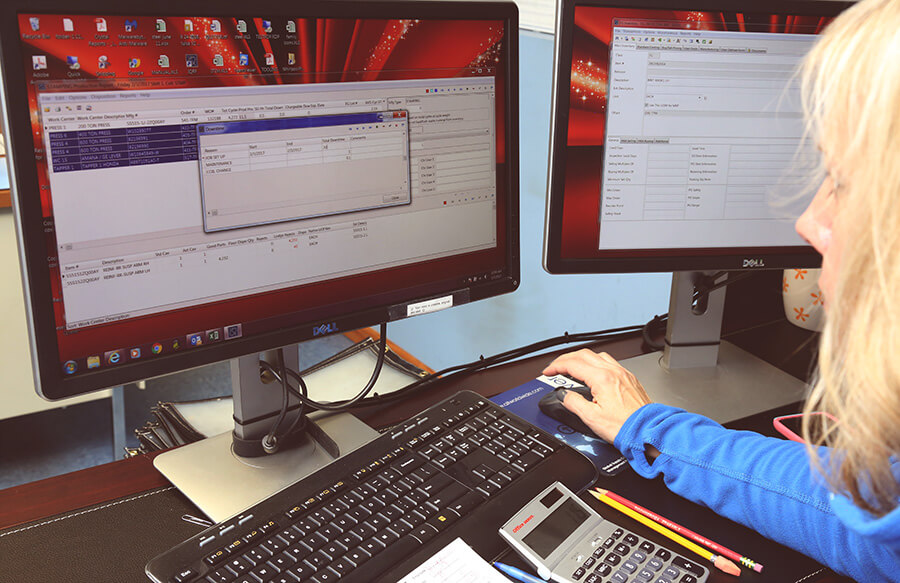 Technology is only one aspect of this change to digital manufacturing. For ERP to succeed, expect to put effort into changing processes and mindsets as
well. People will be both the enabler and the most significant obstacle in most cases. Those who are now the key holders of knowledge may feel threatened.
Project Readiness
Setting up a manufacturing ERP project is a significant undertaking. The most successful selections and implementations result from the of best subject-matter experts in every department devoting time to them. For the project to work well, their understanding of best practices and real-world processes will be essential. Plan for resistance and plenty of hard work, with ups and downs in the mood.
*This summary is an abbreviated version of the research and does not contain the full content. Please visit our sponsor Dassault Systèmes for the full research (registration required).
If you have difficulty obtaining a copy of the report, please contact us.
[post_title] => (Re)Gaining Control in Manufacturing (eBook)
[post_excerpt] =>
[post_status] => publish
[comment_status] => open
[ping_status] => open
[post_password] =>
[post_name] => manufacturing-erp-ebook
[to_ping] =>
[pinged] =>
[post_modified] => 2022-11-14 22:28:26
[post_modified_gmt] => 2022-11-15 03:28:26
[post_content_filtered] =>
[post_parent] => 0
[guid] => https://tech-clarity.com/?p=10977
[menu_order] => 0
[post_type] => post
[post_mime_type] =>
[comment_count] => 0
[filter] => raw
)
[16] => WP_Post Object
(
[ID] => 10968
[post_author] => 2574
[post_date] => 2021-10-28 08:28:47
[post_date_gmt] => 2021-10-28 12:28:47
[post_content] =>
Technology is only one aspect of this change to digital manufacturing. For ERP to succeed, expect to put effort into changing processes and mindsets as
well. People will be both the enabler and the most significant obstacle in most cases. Those who are now the key holders of knowledge may feel threatened.
Project Readiness
Setting up a manufacturing ERP project is a significant undertaking. The most successful selections and implementations result from the of best subject-matter experts in every department devoting time to them. For the project to work well, their understanding of best practices and real-world processes will be essential. Plan for resistance and plenty of hard work, with ups and downs in the mood.
*This summary is an abbreviated version of the research and does not contain the full content. Please visit our sponsor Dassault Systèmes for the full research (registration required).
If you have difficulty obtaining a copy of the report, please contact us.
[post_title] => (Re)Gaining Control in Manufacturing (eBook)
[post_excerpt] =>
[post_status] => publish
[comment_status] => open
[ping_status] => open
[post_password] =>
[post_name] => manufacturing-erp-ebook
[to_ping] =>
[pinged] =>
[post_modified] => 2022-11-14 22:28:26
[post_modified_gmt] => 2022-11-15 03:28:26
[post_content_filtered] =>
[post_parent] => 0
[guid] => https://tech-clarity.com/?p=10977
[menu_order] => 0
[post_type] => post
[post_mime_type] =>
[comment_count] => 0
[filter] => raw
)
[16] => WP_Post Object
(
[ID] => 10968
[post_author] => 2574
[post_date] => 2021-10-28 08:28:47
[post_date_gmt] => 2021-10-28 12:28:47
[post_content] => 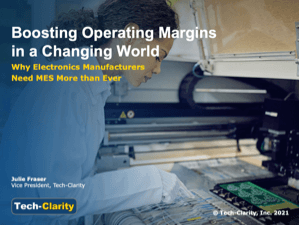 Given the unpredictable supply and market, how can electronics manufacturers prosper? Read Boosting Operating Margins in a Changing World: Why Electronics Manufacturers Need MES More than Ever to see that even the best SMT software is not enough. You’ll hear from us and three major electronics companies’ executives on:
Given the unpredictable supply and market, how can electronics manufacturers prosper? Read Boosting Operating Margins in a Changing World: Why Electronics Manufacturers Need MES More than Ever to see that even the best SMT software is not enough. You’ll hear from us and three major electronics companies’ executives on:
- Recognizing that new business models have expanded the scope and negative impact of the hidden factory
- Meeting customer expectations with smooth IT/OT data flows inherent in Industry 4.0
- Focusing on end-to-end manufacturing data flows
- Standardizing on modern electronics MES for greater profit margins
Table of Contents
- Revenue Opportunity Puts Pressure on Plants
- Hidden Factory
- New Business Models
- Manufacturing Data Challenges
- Managing Manufacturing Data
- Industry 4.0
- Business Pressure to Invest
- Helping Manufacturing Data Flow
- Benefits of Standardizing on MES
- Recommendations
- Conclusion / Call to Action
Executive Summary
The smart connected world presents enormous growth opportunities for electronics manufacturers, including components, boards, substrates, contract manufacturers, and OEMs. Yet, that growth comes with product and application diversity and price pressures. That combination of factors creates tremendous challenges to keep operating margins and profit healthy. Improved manufacturing data management can address many of those challenges. Fortunately, a proven solution is to add a modern Industry 4.0-ready manufacturing execution system (MES).Conclusion
Operational Benefits Modernizing the manufacturing data landscape has clear benefits for electronics operations. Systems must deliver visibility and coherent data for • day-to-day operating • ease of delivering data to customers • being agile in the face of relentless change • ability to support advanced analytics for continued improvements Bottom-line Impact Good manufacturing data management can also support lower operating costs, continuous improvement, and productivity. Modern MES, with its data flows and context, can help nearly everyone. This includes IT and OT staff trying to maintain their systems, engineers working to understand how well their designs are performing, operators and supervisors making splitsecond decisions, or executives making business and partnership decisions. Top-line Impact Customers demand that electronics companies ship reliable and complete data with products. Modern MES delivers track and trace, but so much more to ensure data and products meet requirements. In this way, MES can boost top-line revenues, design wins, and ongoing loyalty. Act Now to Protect Profits Electronics companies must not be complacent. Applications, products, and business models are changing. Many older systems cannot support the business’s most profitable aspects, such as outsourced services for design, assembly, testing, and logistics. The good news is, today’s modern MES can act as the manufacturing data management system you need to meet expectations and boost operating profits. *This summary is an abbreviated version of the research and does not contain the full content. Please visit our sponsor Critical Manufacturing for the full research (registration required). If you have difficulty obtaining a copy of the report, please contact us. [post_title] => Boosting Electronics Operating Margins in an Uncertain World (eBook) [post_excerpt] => [post_status] => publish [comment_status] => open [ping_status] => open [post_password] => [post_name] => electronics-mes-ebook [to_ping] => [pinged] => [post_modified] => 2022-11-14 22:28:25 [post_modified_gmt] => 2022-11-15 03:28:25 [post_content_filtered] => [post_parent] => 0 [guid] => https://tech-clarity.com/?p=10968 [menu_order] => 0 [post_type] => post [post_mime_type] => [comment_count] => 0 [filter] => raw ) [17] => WP_Post Object ( [ID] => 10947 [post_author] => 2 [post_date] => 2021-10-06 22:15:14 [post_date_gmt] => 2021-10-07 02:15:14 [post_content] =>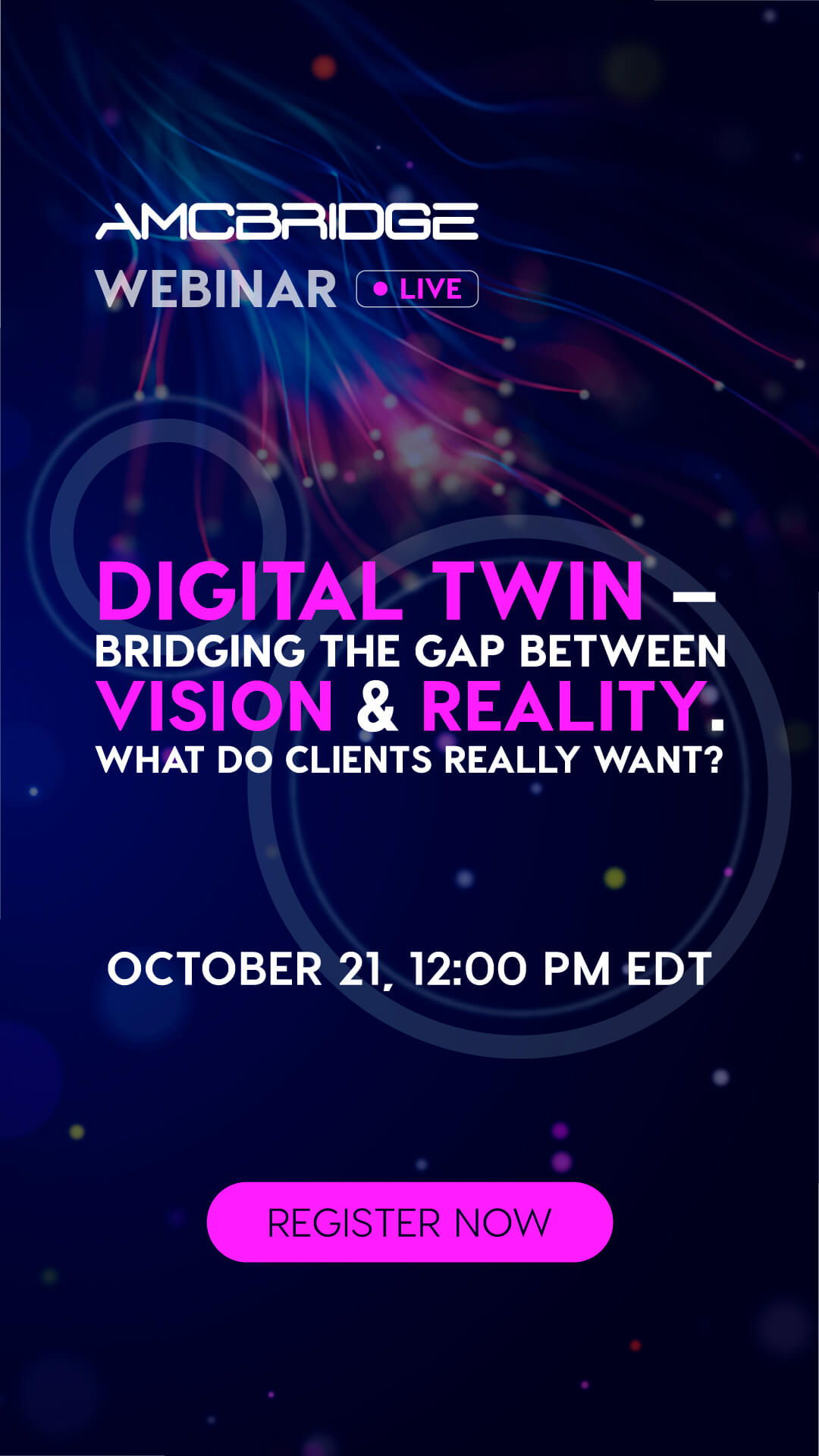 What’s the difference between the vision and the reality of the AEC digital twin? What do clients really want? This webinar asks the experts to weigh in.
Increasing focus on digitalization has spurred interest in the concepts and benefits of digital twins. Companies and organizations worldwide strive to leverage digital twins to become more efficient and ensure the reliability and safety of their products, services, and facilities. But do we all understand the digital twin concept in the same way? This webinar on October 21st at 12PM EDT will explore the nature of related technologies, dig into the differences between the digital twin and BIM, and cover other hot questions the industry wants to know.
Register now to hear from industry experts. For more information on the event and panelists, visit AMC Bridge's event page.
What’s the difference between the vision and the reality of the AEC digital twin? What do clients really want? This webinar asks the experts to weigh in.
Increasing focus on digitalization has spurred interest in the concepts and benefits of digital twins. Companies and organizations worldwide strive to leverage digital twins to become more efficient and ensure the reliability and safety of their products, services, and facilities. But do we all understand the digital twin concept in the same way? This webinar on October 21st at 12PM EDT will explore the nature of related technologies, dig into the differences between the digital twin and BIM, and cover other hot questions the industry wants to know.
Register now to hear from industry experts. For more information on the event and panelists, visit AMC Bridge's event page.
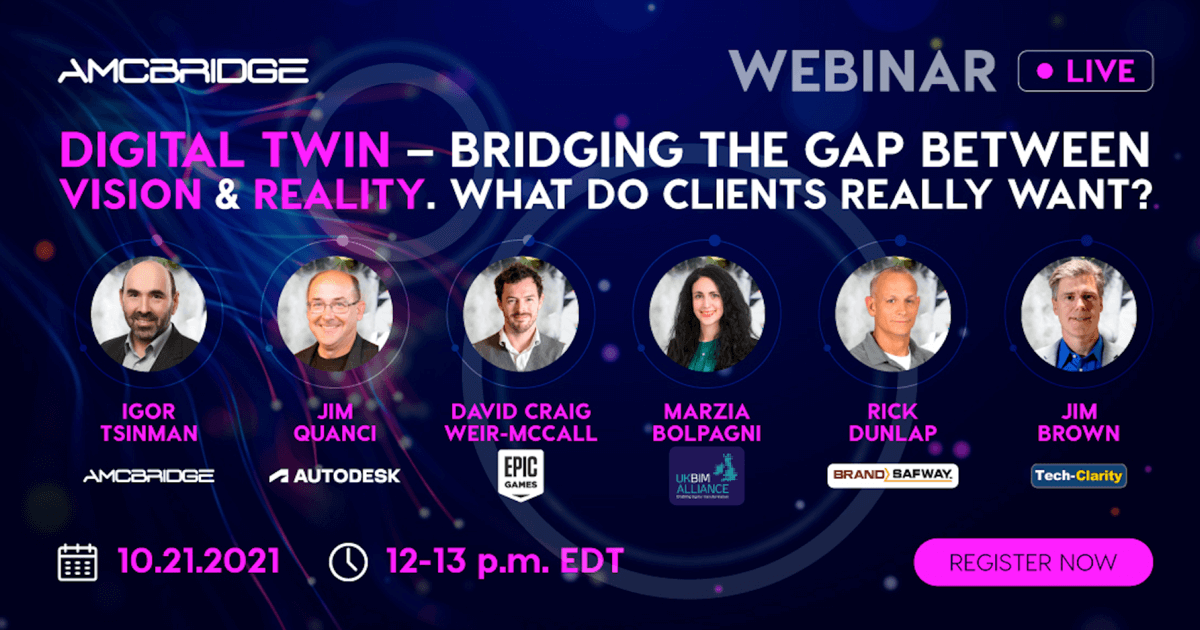 Moderator: Jim Brown, Tech-Clarity
Panelists:
Moderator: Jim Brown, Tech-Clarity
Panelists:
- Igor Tsinman, Co-Founder and President of AMC Bridge
- Marzia Bolpagni, UK BIM Alliance Ambassador
- Rick Dunlap, Technical Services Vice President of BrandSafway
- David Craig Weir-McCall, Business Development Manager of Unreal Engine Enterprise of Epic Games
- Jim Quanci, Senior Director of ADN partnerships of Autodesk
 Should quality management and product lifecycle management be a single system?
As companies seek better digital continuity, the answer might appear to be yes. And yet, it may not work in every company. Register now to hear arguments on both sides of this debate on Tuesday, October 13 at 11 am Eastern, 8 am Pacific, 17:00 GMT. We’ll respond to these questions:
Should quality management and product lifecycle management be a single system?
As companies seek better digital continuity, the answer might appear to be yes. And yet, it may not work in every company. Register now to hear arguments on both sides of this debate on Tuesday, October 13 at 11 am Eastern, 8 am Pacific, 17:00 GMT. We’ll respond to these questions:
- Must PLM and QMS be part of the same system?
- How will PLM and QMS software providers respond to industry trends such as data management platforms, focusing on customer experience, creating vertical solutions?
- What interesting things are happening in the PLM and QMS markets?
- What do we think of Propel and its approach?
- What’s in the crystal ball for the next couple of years?
 How can manufacturers adopt cloud PLM to support digital transformation but avoid being stuck with a dead-end, custom system? Is it time to force a hard decision between customization and the cloud? Read Digital Transformation Driving PLM to the Cloud to learn what three leading manufacturers and our research have to say.
How can manufacturers adopt cloud PLM to support digital transformation but avoid being stuck with a dead-end, custom system? Is it time to force a hard decision between customization and the cloud? Read Digital Transformation Driving PLM to the Cloud to learn what three leading manufacturers and our research have to say.
- How today’s manufacturers are leveraging cloud PLM to support their digital transformation initiatives
- The business triggers that lead to upgrading current PLM solutions
- The compelling benefits of cloud and architecture choices that need to be made
- How low-code PLM can support digital transformation
Table of Contents
- Executive Summary
- The Manufacturer's Viewpoint on PLM
- The Need to Upgrade PLM
- Cloud is Compelling
- Evaluating PLM Deployment Options
- Out-of-the-Box (OOTB) is a Fallacy
- Functionality First
- Cloud and Custom Aren't Incompatible
- Key Takeaways
- Acknowledgments
Executive Summary
Digital Transformation Demands New Capabilities, Agility Digital transformation is intensifying the need to tailor PLM systems to serve as a company’s digital backbone and support new ways of innovating and operating. Engineers need the latest features and capabilities, but also need to keep the “right-for-me” PLM capabilities they already have. PLM solutions that are customized to achieve these goals, however, can create an ongoing need for specialized services that can limit agility and prevent adoption of new features and software versions. Transitioning to the Cloud Cloud solutions are compelling but are not commonly as tailorable as traditional solutions to provide a customized experience. Cloud offers numerous business and technical advantages including lower costs, less need for IT support, strong security, high availability, and practically infinite scalability. The tradeoff is typically a more out-of-the-box (OOTB) solution with lower ability to customize to enforce company standards and provide the right experience to the end user. "Cloud" and "Customization" can Co-Exist Our experience shows that most PLM implementations are not OOTB, especially for large organizations. This creates tension between cloud benefits and creating the new digital backbone and a “right-for-me” experience. As our experience and the research for this eBook shows, however, the right balance between cloud benefits and desired customization may be available through the emerging alternative to customization, low-code / no-code development.Evaluating PLM Deployment Options
Cloud Comes in a Variety of Options Cloud is compelling, but “the cloud” is not a single option. There are multiple ways to implement PLM. Let’s look at the impacts of the different options on factors like cost, agility, and the ability to customize for the “right for me” experience. Note that these are generalizations and we recognize that there are exceptions to every rule.
Key Takeaways
 Research for this report leads our analysts to the following conclusions:
Research for this report leads our analysts to the following conclusions:
- PLM is becoming the digital backbone for manufacturers’ digital transformation strategy
- Most engineers prioritize PLM functionality and the “right-for-me” experience over cloud benefits. Traditional customization approaches lead to large technical debt and can result in dead-end customizations.
- PLM is a business imperative, and like the business, it’s a moving target. It’s important to have the ability to adapt the PLM system as needs change, to remain agile, without adding technical debt.
- Cloud and customization can both be options at the same time. The right PLM architecture can provide cloud benefits while also enabling customization without incurring significant technical debt.
 How much better would your products be if you could improve engineering productivity by reducing engineering time wasters?
Engineers regularly lose productivity to non-value-add tasks that not only rob them of their ability to innovate, but also threaten their company’s ability to compete, differentiate, and grow. Imagine the potential of identifying and removing the most common non-value-add activities engineers face and empowering them to focus on better products. This research, The Business Value of Reducing Engineering Time Wasters, examines how engineers spend their time, where they lose productivity, and the impact on the business. It then identifies solutions and approaches to reduce time wasters. Based on a survey of 228 manufacturers, it focuses on smaller and medium-sized companies and looks at the challenges and opportunities from their perspective.
Please enjoy the summary* below. For the full research, please visit our sponsor Siemens (registration required).
How much better would your products be if you could improve engineering productivity by reducing engineering time wasters?
Engineers regularly lose productivity to non-value-add tasks that not only rob them of their ability to innovate, but also threaten their company’s ability to compete, differentiate, and grow. Imagine the potential of identifying and removing the most common non-value-add activities engineers face and empowering them to focus on better products. This research, The Business Value of Reducing Engineering Time Wasters, examines how engineers spend their time, where they lose productivity, and the impact on the business. It then identifies solutions and approaches to reduce time wasters. Based on a survey of 228 manufacturers, it focuses on smaller and medium-sized companies and looks at the challenges and opportunities from their perspective.
Please enjoy the summary* below. For the full research, please visit our sponsor Siemens (registration required).
Table of Contents
- Executive Summary
- Product Development Is Critical to Business Strategies
- The Time Wasters
- Implications of Time Wasters to the Business
- A Solution to Avoid Time Wasters
- Defining Product Complexity
- Business Value from PLM
- Extending PLM Use Results in Greater Satisfaction
- How Companies implement PLM
- Additional Values Due to the Cloud
- Conclusions
- Recommendations
- About the Research
- Acknowledgments
Executive Summary
Engineers Impact Business Success Exceptional products are critical to success, regardless of whether a company's business strategy is to grow or improve margins. Likewise, engineers are crucial to ensuring products have what it takes to succeed in the market. Therefore, empowering engineers is key to the successful execution of business strategies. Too Many Time Wasters
Unfortunately, engineers report spending too much time on non-value-added work with too many interruptions, taking them away from critical innovation work. Furthermore, 96% of surveyed companies say this loss in engineering productivity comes at a significant business cost due to missed deadlines, higher costs, less innovation, and poor quality. To overcome productivity losses, one approach is to manage product data better and make it accessible to those who need it, when they need it.
Reclaiming Wasted Time
This report identifies major engineering time wasters and examines them across the dimensions of both company size and product complexity. It explores how companies of all sizes reclaim lost time by examining the use and value of PLM (Product Lifecycle Management) solutions to centralize data across multiple domains, manage processes, and collaborate better. PLM users reported fewer changes due to outdated information and errors, significantly reducing non-value-added work and shortening development times. This report also looks at how companies select and use PLM solutions, including cloud-based implementations.
Too Many Time Wasters
Unfortunately, engineers report spending too much time on non-value-added work with too many interruptions, taking them away from critical innovation work. Furthermore, 96% of surveyed companies say this loss in engineering productivity comes at a significant business cost due to missed deadlines, higher costs, less innovation, and poor quality. To overcome productivity losses, one approach is to manage product data better and make it accessible to those who need it, when they need it.
Reclaiming Wasted Time
This report identifies major engineering time wasters and examines them across the dimensions of both company size and product complexity. It explores how companies of all sizes reclaim lost time by examining the use and value of PLM (Product Lifecycle Management) solutions to centralize data across multiple domains, manage processes, and collaborate better. PLM users reported fewer changes due to outdated information and errors, significantly reducing non-value-added work and shortening development times. This report also looks at how companies select and use PLM solutions, including cloud-based implementations.
Conclusions
Reclaiming Lost Time Smaller and medium-sized companies prioritize their future growth and sustained success on winning in the marketplace with better, differentiated products. To support this, they can give their product development capabilities a significant boost by eliminating the time wasters that consume engineers' valuable time. Companies of all sizes find that PLM can empower their engineers to innovate by significantly reducing engineers' time on non-value-added tasks. As a result, they can enjoy a competitive advantage. In addition, technology advances, such as cloud-based offerings, can reduce implementation time, cost, and difficulty, making PLM more accessible to smaller and medium-sized companies.Recommendations
Next Steps Based on industry experience and research for this report, Tech-Clarity offers the following recommendations to smaller and medium-sized companies:
Based on industry experience and research for this report, Tech-Clarity offers the following recommendations to smaller and medium-sized companies:
- Consider the business impact of engineering time wasters on your company and make investments to minimize them. By empowering engineers to focus more time on value-added work, you will get to market faster with better, more differentiated products.
- Consider how challenging it can be to find and recruit engineering talent in today’s business climate. Freeing engineers from time-wasting tasks can help take some pressure off your existing staff, improving their work environment and productivity, and reducing the need to add more.
- Look at PLM as a potential solution to reduce engineering time wasters. Smaller and medium-sized companies report that PLM offers benefits such as centralizing data, supporting multiple domains, managing processes, and improving collaboration. This frees engineers from tasks that waste their time so they can focus more on engineering and innovation.
- Use PLM for more than managing data. Those most satisfied with PLM also use it to manage engineering change processes, access control, requirements, and release processes.
- Extend the use of PLM to a broader audience beyond engineering. Those most satisfied with it include management, manufacturing, quality, and sales as users.
- Select a solution that has the flexibility to configure to your processes. An overwhelming 74% who found the implementation easy, identified this as helpful to the implementation.
- Consider a cloud solution. Interestingly, 78% of those who implemented a cloud solution considered the deployment easy and implemented it in half the time required by those using a non-cloud solution.
All Results for "All"
Engineering Buyer’s Guide for Multi-Discipline Systems
What should you look for in a systems engineering solution for your company to manage multi-discipline systems? As products become smarter and more connected, they also get more complex. Expert systems engineering practices can help to manage this complexity, especially when you are developing multi-discipline systems. The right technology can also be critical to support…
Bouncing Forward with Smart Manufacturing (guest post)
How can manufacturers bounce forward from disruption with smart manufacturing? Read our short post for some insights from our research and then join a live event to learn from Tech-Clarity’s Jim Brown and a variety of other speakers in a live Industry 4.0 event. Industry Disruption is the New Normal Today’s global manufacturing industry is…
The State of PLM in CPG (survey results)
Is PLM living up to its potential in consumer packaged goods? Is it ready to support today’s digital transformation strategies? What is the status quo for PLM in CPG? We surveyed over 150 companies to find out. Please enjoy the summary below.* For the full report, please visit our sponsor Kalypso (registration required). Table of Contents The…
Increasing Performance Engineering Maturity (eBook)
How can increasing performance engineering maturity help manufacturers ensure they’ve fully optimized equipment performance? How does “shifting left” with simulation and closed-loop feedback help improve performance without compromising project due dates? Please enjoy the summary* below. For the full research, please visit our sponsor Siemens (registration required). Table of Contents The Performance Engineering Imperative Predicting…
Knowledge is Power: The Secrets of Industry 4.0 (live event)
What do industry experts and your manufacturing peers have to say about smart manufacturing? Join this live event on April 28th in Cleveland, Ohio to find out. Our own Jim Brown will keynote the conference, sharing his views on how manufacturers can “bounce forward” from recent disruptions with smart manufacturing solutions. Then you’ll hear from…
Industrial Design: 7 Ways to Reduce Non-Value-Added Work
How much of your industrial design work can be leveraged during detail design? Could your products be even better if you had more time to get concepts right by reducing non-value-added work? An overwhelming 76% of manufacturers agree that spending more time on concept and industrial design would improve products. Unfortunately, industrial designers waste significant…
Operations Data Management: Five Facets to Gain Batch Process Insights
What makes it so difficult to manage operations data and achieve AI success in batch process industries? There are many valid answers, and it’s crucial to address them all. In this white paper, we explore special issues around mindset, complexity, multiple disciplines, and a variety of dispersed data. We also address how these batch process…
Driving Tech Transfer Performance in Life Sciences (eBook)
Our research shows that companies with the highest tech transfer performance digitalize their tech transfer data and processes. But what does digital tech transfer look like, and how do you get there? This how-to guide shows life sciences companies the way. Please enjoy the summary* below. For the full research, please visit our sponsor Dassault…
Five Ways Simulation Enables Startups
How can startup companies improve their chances of success? Our Startup Survival Guide reveals both how and why simulation can provide startups an edge to launch a successful product. As part of a cloud platform, CAE can also be more accessible to startups. Please enjoy the summary* below. For the full research, please visit our…
Choose the Right PDM System (buyer’s guide)
How can you ensure that you choose the right PDM software and partner for your business? The right system serves as the backbone for digital transformation and impacts productivity, product success, and profitability. How can you make sure to get it right? Please enjoy the summary* below. For the full research, please visit our sponsor…
A Digital Approach to System Family Engineering
How do you manage system family engineering? As today’s products become increasingly complex, managing their different configurations becomes exponentially more challenging. Trying to trace which features you need to support required functions can be tedious, time-consuming, and error-prone. At the same time, the age of digital transformation has driven companies to find new ways to…
Reimagining Semiconductor MES (eBook)
What could justify replacing the MES in an operating semiconductor fab? Advanced capabilities that traditional MES cannot model or support. Significant changes in the business of making microelectronics have created the need for much greater agility and complexity of processing. Seeking out a system that can support current operations is crucial to ongoing competitiveness. Reimagining…
ENOVIA Champions Leading the Way to Digital Transformation (guest post)
I had the pleasure of joining Dassault Systemes’ special ENOVIA Champions Advisory Board Meeting at the end of 2021. It was a unique learning opportunity because the Champions are a global community of people that use or support ENOVIA and the 3DEXPERIENCE platform at their companies. It was also nice to see some industry friends…
How to Reduce Non-Value-Added Work in Engineering
Did you know engineers waste so much time on non-value-added work, they only spend about 54% of their time actually designing? How can you prevent them from wasting too much time on non-value-added work? Our research uncovered some significant engineering inefficiencies that contribute to this including: 29% percent of engineering time is spent working with…
(Re)Gaining Control in Manufacturing (eBook)
How can manufacturers succeed in the face of uncertainty that creates new needs for decision-makers at every level? Read (Re)Gaining Control in Manufacturing: The Right ERP can Ensure Uncertainty Doesn’t Restrict Your Growth to learn how and hear from three executives who have done it. Why the right fit modern, comprehensive, and factory-capable ERP opens…
Boosting Electronics Operating Margins in an Uncertain World (eBook)
Given the unpredictable supply and market, how can electronics manufacturers prosper? Read Boosting Operating Margins in a Changing World: Why Electronics Manufacturers Need MES More than Ever to see that even the best SMT software is not enough. You’ll hear from us and three major electronics companies’ executives on: Recognizing that new business models have…
Digital Twin – Bridging the Gap Between Vision and Reality (webcast)
What’s the difference between the vision and the reality of the AEC digital twin? What do clients really want? This webinar asks the experts to weigh in. Increasing focus on digitalization has spurred interest in the concepts and benefits of digital twins. Companies and organizations worldwide strive to leverage digital twins to become more efficient…
PLM and QMS: Better Together or Apart? (Virtual Event)
Should quality management and product lifecycle management be a single system? As companies seek better digital continuity, the answer might appear to be yes. And yet, it may not work in every company. Register now to hear arguments on both sides of this debate on Tuesday, October 13 at 11 am Eastern, 8 am Pacific,…
Digital Transformation is Driving PLM to the Cloud
How can manufacturers adopt cloud PLM to support digital transformation but avoid being stuck with a dead-end, custom system? Is it time to force a hard decision between customization and the cloud? Read Digital Transformation Driving PLM to the Cloud to learn what three leading manufacturers and our research have to say. How today’s manufacturers…












